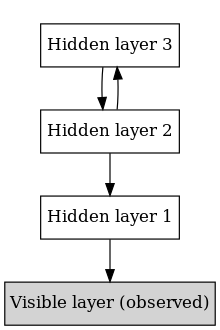
Back شبكة الاعتقاد العميق Arabic Xarxa de creença profunda Catalan Red de creencia profunda Spanish شبکه باور عمیق Persian 심층 신뢰 신경망 Korean Глубокая сеть доверия Russian Глибока мережа переконань Ukrainian 深度信念網絡 ZH-YUE

| Part of a series on |
| Machine learning and data mining |
|---|
In machine learning, a deep belief network (DBN) is a generative graphical model, or alternatively a class of deep neural network, composed of multiple layers of latent variables ("hidden units"), with connections between the layers but not between units within each layer.[1]
When trained on a set of examples without supervision, a DBN can learn to probabilistically reconstruct its inputs. The layers then act as feature detectors.[1] After this learning step, a DBN can be further trained with supervision to perform classification.[2]
DBNs can be viewed as a composition of simple, unsupervised networks such as restricted Boltzmann machines (RBMs)[1] or autoencoders,[3] where each sub-network's hidden layer serves as the visible layer for the next. An RBM is an undirected, generative energy-based model with a "visible" input layer and a hidden layer and connections between but not within layers. This composition leads to a fast, layer-by-layer unsupervised training procedure, where contrastive divergence is applied to each sub-network in turn, starting from the "lowest" pair of layers (the lowest visible layer is a training set).
The observation[2] that DBNs can be trained greedily, one layer at a time, led to one of the first effective deep learning algorithms.[4]: 6 Overall, there are many attractive implementations and uses of DBNs in real-life applications and scenarios (e.g., electroencephalography,[5] drug discovery[6][7][8]).
- ^ a b c Hinton G (2009). "Deep belief networks". Scholarpedia. 4 (5): 5947. Bibcode:2009SchpJ...4.5947H. doi:10.4249/scholarpedia.5947.
- ^ a b Hinton GE, Osindero S, Teh YW (July 2006). "A fast learning algorithm for deep belief nets" (PDF). Neural Computation. 18 (7): 1527–54. CiteSeerX 10.1.1.76.1541. doi:10.1162/neco.2006.18.7.1527. PMID 16764513. S2CID 2309950.
- ^ Bengio Y, Lamblin P, Popovici D, Larochelle H (2007). Greedy Layer-Wise Training of Deep Networks (PDF). NIPS.
- ^ Bengio, Y. (2009). "Learning Deep Architectures for AI" (PDF). Foundations and Trends in Machine Learning. 2: 1–127. CiteSeerX 10.1.1.701.9550. doi:10.1561/2200000006.
- ^ Movahedi F, Coyle JL, Sejdic E (May 2018). "Deep Belief Networks for Electroencephalography: A Review of Recent Contributions and Future Outlooks". IEEE Journal of Biomedical and Health Informatics. 22 (3): 642–652. doi:10.1109/jbhi.2017.2727218. PMC 5967386. PMID 28715343.
- ^ Ghasemi, Pérez-Sánchez; Mehri, Pérez-Garrido (2018). "Neural network and deep-learning algorithms used in QSAR studies: merits and drawbacks". Drug Discovery Today. 23 (10): 1784–1790. doi:10.1016/j.drudis.2018.06.016. PMID 29936244. S2CID 49418479.
- ^ Ghasemi, Pérez-Sánchez; Mehri, fassihi (2016). "The Role of Different Sampling Methods in Improving Biological Activity Prediction Using Deep Belief Network". Journal of Computational Chemistry. 38 (10): 1–8. doi:10.1002/jcc.24671. PMID 27862046. S2CID 12077015.
- ^ Gawehn E, Hiss JA, Schneider G (January 2016). "Deep Learning in Drug Discovery". Molecular Informatics. 35 (1): 3–14. doi:10.1002/minf.201501008. PMID 27491648. S2CID 10574953.